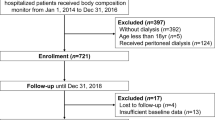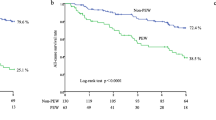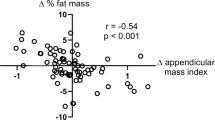Abstract
Background
Inadequate fluid removal or high water intake leads to overhydration, which results in malnutrition. The aim of the present study was to evaluate the effects of volume status on body composition in incident peritoneal dialysis (PD) patients.
Methods
All incident PD patients who survived ≥1 year after PD initiation were considered eligible. A total of 366 incident PD patients were finally included and divided into three tertiles according to the time-averaged-edema index (TA-EI). The body composition parameters measured using bioimpedance analysis included the EI, fat mass index (FMI, kg/m2), and appendicular muscle mass index (AMMI, kg/m2). dFMI and dAMMI were defined as delta values for each variable. The cutoff value for sarcopenia (SP) was defined as previously reported. Patients with AMMI below the cutoff values were defined as having SP.
Results
The number of participants in the low, middle, and high tertiles was 126, 100, and 140, respectively. A high volume status was associated with high solute clearance, albumin loss, and glucose absorption through the peritoneal membrane, which led to high dialysate glucose. In addition, volume status was inversely associated with increases in AMMI, but was not associated with changes in FMI. SP as a categorical variable was positively associated with a high volume status. On subgroup analyses, TA-EI had the greatest negative correlation coefficients for dAMMI.
Conclusion
Overhydration in PD patients was associated with decrease in muscle mass indices and the development of SP.
This is a preview of subscription content, access via your institution
Access options
Subscribe to this journal
Receive 12 print issues and online access
$259.00 per year
only $21.58 per issue
Buy this article
- Purchase on Springer Link
- Instant access to full article PDF
Prices may be subject to local taxes which are calculated during checkout

Similar content being viewed by others
References
Foley RN, Parfrey PS, Harnett JD, Kent GM, Martin CJ, Murray DC, et al. Clinical and echocardiographic disease in patients starting end-stage renal disease therapy. Kidney Int. 1995;47:186–92.
Enia G, Mallamaci F, Benedetto FA, Panuccio V, Parlongo S, Cutrupi S, et al. Long-term CAPD patients are volume expanded and display more severe left ventricular hypertrophy than haemodialysis patients. Nephrol Dial Transplant. 2001;16:1459–64.
Koc M, Toprak A, Tezcan H, Bihorac A, Akoglu E, Ozener IC. Uncontrolled hypertension due to volume overload contributes to higher left ventricular mass index in CAPD patients. Nephrol Dial Transplant. 2002;17:1661–6.
Aguilera A, Codoceo R, Selgas R, Garcia P, Picornell M, Diaz C, et al. Anorexigen (TNF-alpha, cholecystokinin) and orexigen (neuropeptide Y) plasma levels in peritoneal dialysis (PD) patients: their relationship with nutritional parameters. Nephrol Dial Transplant. 1998;13:1476–83.
Niebauer J, Volk HD, Kemp M, Dominquez M, Schumann RR, Rauchhaus M, et al. Endotoxin and immune activation in chronic heart failure: a prospective cohort study. Lancet. 1999;353:1838–42.
Fahal IH. Uraemic sarcopenia: aetiology and implications. Nephrol Dial Transplant. 2014;29:1655–65.
Kang SH, Cho KH, Park JW, Do JY. Low appendicular muscle mass is associated with mortality in peritoneal dialysis patients: a single-center cohort study. Eur J Clin Nutr. 2017;71:1405–10.
Abro A, Delicata LA, Vongsanim S, Davenport A. Differences in the prevalence of sarcopenia in peritoneal dialysis patients using hand grip strength and appendicular lean mass: depends upon guideline definitions. Eur J Clin Nutr. 2018;72:993–9.
Kamijo Y, Kanda E, Ishibashi Y, Yoshida M. Sarcopenia and frailty in PD: impact on mortality, malnutrition, and inflammation. Perit Dial Int. 2018;38:447–54.
Bataille S, Serveaux M, Carreno E, Pedinielli N, Darmon P, Robert A. The diagnosis of sarcopenia is mainly driven by muscle mass in hemodialysis patients. Clin Nutr. 2017;36:1654–60.
Giglio J, Kamimura MA, Lamarca F, Rodrigues J, Santin F, Avesani CM. Association of sarcopenia with nutritional parameters, quality of life, hospitalization, and mortality rates of elderly patients on hemodialysis. J Ren Nutr. 2018;28:197–207.
Yoowannakul S, Tangvoraphonkchai K, Vongsanim S, Mohamed A, Davenport A. Differences in the prevalence of sarcopenia in haemodialysis patients: the effects of gender and ethnicity. J Hum Nutr Diet. 2018;31:689–96.
Ren H, Gong D, Jia F, Xu B, Liu Z. Sarcopenia in patients undergoing maintenance hemodialysis: incidence rate, risk factors and its effect on survival risk. Ren Fail. 2016;38:364–71.
Ellis KJ. Human body composition: in vivo methods. Physiol Rev. 2000;80:649–80.
Edfonti A, Mastrangelo A, Paglialonga F. Assessment and monitoring of nutrition status in pediatric peritoneal dialysis patients. Perit Dial Int. 2009;29:S176–9.
Jackson AS, Pollock ML, Graves JE, Mahar MT. Reliability and validity of bioelectrical impedance in determining body composition. J Appl Physiol. 1988;64:529–34.
Zillikens MC, van den Berg JW, Wilson JH, Rietveld T, Swart GR. The validity of bioelectrical impedance analysis in estimating total body water in patients with cirrhosis. J Hepatol. 1992;16:59–65.
Malavolti M, Mussi C, Poli M, Fantuzzi AL, Salvioli G, Battistini N, et al. Cross-calibration of eight-polar bioelectrical impedance analysis versus dual-energy X-ray absorptiometry for the assessment of total and appendicular body composition in healthy subjects aged 21–82 years. Ann Hum Biol. 2003;30:380–91.
Mushnick R, Fein PA, Mittman N, Goel N, Chattopadhyay J, Avram MM. Relationship of bioelectrical impedance parameters to nutrition and survival in peritoneal dialysis patients. Kidney Int Suppl. 2003;87:S53–6.
Rhee H, Baek MJ, Chung HC, Park JM, Jung WJ, Park SM, et al. Extracellular volume expansion and the preservation of residual renal function in Korean peritoneal dialysis patients: a long-term follow up study. Clin Exp Nephrol. 2016;20:778–86.
Ling CH, de Craen AJ, Slagboom PE, Gunn DA, Stokkel MP, Westendorp RG, et al. Accuracy of direct segmental multi-frequency bioimpedance analysis in the assessment of total body and segmental body composition in middle-aged adult population. Clin Nutr. 2011;30:610–5.
Raimann JG, Zhu F, Wang J, Thijssen S, Kuhlmann MK, Kotanko P, et al. Comparison of fluid volume estimates in chronic hemodialysis patients by bioimpedance, direct isotopic, and dilution methods. Kidney Int. 2014;85:898–908.
Shu Y, Liu J, Zeng X, Hong HG, Li Y, Zhong H, et al. The effect of overhydration on mortality and technique failure among peritoneal dialysis patients: a systematic review and meta-analysis. Blood Purif. 2018;46:350–8.
van Biesen W, Heimburger O, Krediet R, Rippe B, La Milia V, Covic A, et al. Evaluation of peritoneal membrane characteristics: clinical advice for prescription management by the ERBP working group. Nephrol Dial Transpl. 2010;25:2052–62.
Watson P, Watson I, Batt R. Total body water volumes for adult males and females estimated from simple anthropometric measurements. Am J Clin Nutr. 1980;33:27–39.
National Kidney Foundation. KDOQI Clinical practice guidelines for nutrition in chronic renal failure. Am J Kidney Dis. 2000;35 6 Suppl 2:S1–140.
Chen LK, Liu LK, Woo J, Assantachai P, Auyeung TW, Bahyah KS, et al. Sarcopenia in Asia: consensus report of the Asian Working Group for Sarcopenia. J Am Med Dir Assoc 2014;15:95–101.
van Biesen W, Claes K, Covic A, Fan S, Lichodziejewska-Niemierko M, Schoder V. et al. A multicentric, international matched pair analysis of body composition in peritoneal dialysis versus haemodialysis patients. Nephrol Dial Tranplant. 2013;28:2620–8.
Demirci MS, Demirci C, Ozdogan O, Kircelli F, Akcicek F, Basci A, et al. Relations between malnutrition-inflammation-atherosclerosis and volume status. The usefulness of bioimpedance analysis in peritoneal dialysis patients. Nephrol Dial Transplant. 2011;26:1708–16.
Fan S, Sayed RH, Davenport A. Extracellular volume expansion in peritoneal dialysis patients. Int J Artif Organs 2012;35:338–45.
Johnson DW, Mudge DW, Sturtevant JM, Hawley CM, Campbell SB, Isbel NM, et al. Predictors of decline of residual renal function in new peritoneal dialysis patients. Perit Dial Int. 2003;23:276–83.
Watsuda A, Matsumura O, Ogawa T, Tayama Y, Motojima M, Maeda T, et al. Contribution of residual renal function on peritoneal solute transport in dialysis patients. Am J Nephrol. 2010;32:187–93.
Kang SH, Cho KH, Park JW, Yoon KW, Do JY. Body composition measurements using bioimpedance analysis in peritoneal dialysis patients are affected by the presence of dialysate. Nephrology. 2014;19:727–31.
Kang SH, Cho KH, Park JW, Yoon KW, Do JY. Comparison of bioimpedance analysis and dual-energy X-ray absorptiometry body composition measurements in peritoneal dialysis patients according to edema. Clin Nephrol. 2013;79:261–8.
Waki M, Kral JG, Mazariegos M, Wang J, Pierson RN Jr, Heymsfield SB. Relative expansion of extracellular fluid in obese vs. nonobese women. Am J Physiol. 1991;261:E199–E203.
Formica C, Atkinson MG, Nyulasi I, McKay J, Heale W, Seeman E. Body composition following hemodialysis: studies using dual-energy X-ray absorptiometry and bioelectrical impedance analysis. Osteoporos Int. 1993;3:192–7.
Kang SH, Cho KH, Park JW, Yoon KW, Do JY. Association of visceral fat area with chronic kidney disease and metabolic syndrome risk in the general population: analysis using multi-frequency bioimpedance. Kidney Blood Press Res. 2015;40:223–30.
Funding
This work was supported by the Medical Research Center Program (2015R1A5A2009124 to JYD) through the National Research Foundation of Korea (NRF) funded by the Ministry of Science, ICT and Future Planning, and the NRF Grant funded by the Korea government (2017R1C1B5077075 to SHK).
Author information
Authors and Affiliations
Contributions
SHK conceived and designed the work, acquired data, played an important role in interpreting the results and wrote the manuscript. JYD contributed analysis tool, acquired data, and revised the manuscript. SHK and JYD approved the final version.
Corresponding author
Ethics declarations
Conflict of interest
The authors declare that they have no conflict of interest.
Additional information
Publisher’s note Springer Nature remains neutral with regard to jurisdictional claims in published maps and institutional affiliations.
Supplementary information
Rights and permissions
About this article
Cite this article
Kang, S.H., Do, J.Y. Effects of volume status on body composition in incident peritoneal dialysis patients. Eur J Clin Nutr 74, 633–641 (2020). https://doi.org/10.1038/s41430-020-0574-y
Received:
Revised:
Accepted:
Published:
Issue Date:
DOI: https://doi.org/10.1038/s41430-020-0574-y
This article is cited by
-
Association between low handgrip strength and obesity with mortality in peritoneal dialysis patients
Scientific Reports (2023)
-
Impact of volume status on sarcopenia in non-dialysis chronic kidney disease patients
Scientific Reports (2022)
-
Comparison of various indices for predicting sarcopenia and its components in patients receiving peritoneal dialysis
Scientific Reports (2022)
-
Sex difference in the association among nutrition, muscle mass, and strength in peritoneal dialysis patients
Scientific Reports (2022)
-
Nutritional status and volume control in adolescents on chronic hemodialysis
Pediatric Nephrology (2021)



